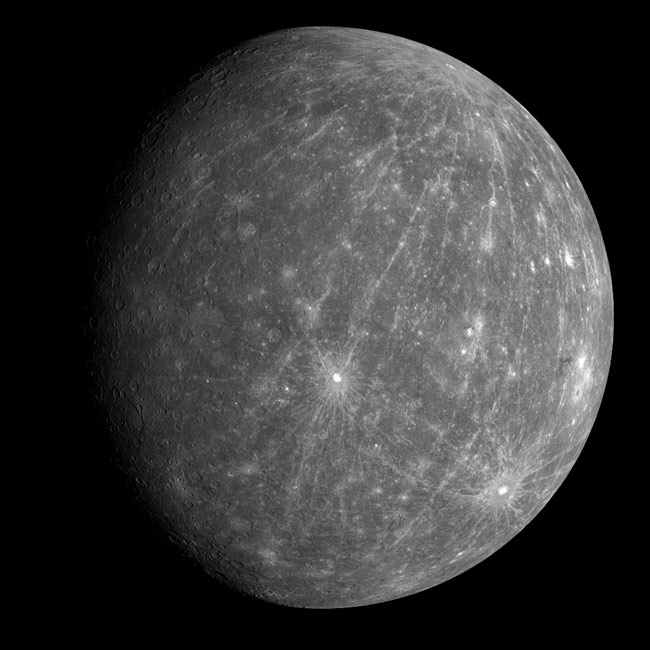Spacecraft Reveals Stunning New Views of Mercury

A NASA probe has begunbeaming back stunning new images from its successful second flyby of Mercury,the planet closest to the sun.
NASA's MESSENGER probecaptured never-before-seen views of the Mercury during its encounteron Monday. The spacecraft zipped past Mercury for the second time this yearand used the planet?s gravity to adjust its path as it continues en route tobecome the first probe to orbit the planet in March 2011.
One new image shows largepatterns of ray-likelines extending southward across much of the planet surface from a young,newly-imaged crater. The previously-imaged Kuiper crater and others craters alsohave similar webs of lines radiating outward.
Another raw picturerepresents the highest-resolutioncolor image ever taken of Mercury's surface, and came just 9 minutes afterthe spacecraft's closest approach to Mercury at 4:43 a.m. EDT (0845 GMT).Details include a large impact basin with an 83-mile (133-km) diameter, namedPolygnotus for a Greek painter from the 5th century B.C.
Yet a third first-time imagecame from MESSENGER's approach to the crescent-shaped Mercury, and is oneof 44 pictures taken as part of a mosaic. Scientists hoped to collect nineimage mosaics total in order to add up to 30 percent of never-before-seenregions of the planet's surface.
The second Mercury flyby ofOct. 6 comes after a firstflyby on Jan. 14, which looked at a different side of the planet.
"When these data havebeen digested and compared, we will have a global perspective of Mercury forthe first time," said Sean Solomon, MESSENGER's principal investigator atthe Carnegie Institution of Washington.
Get the Space.com Newsletter
Breaking space news, the latest updates on rocket launches, skywatching events and more!
Launched in August 2004,MESSENGER — short for MErcury Surface, Space ENvironment, GEochemistry, andRanging — is the first spacecraft in 33 years to greet Mercury up close sinceNASA's earlier Mariner 10 mission of the 1970s. The new probe is slated for athird Mercury flyby in 2009 before finally settling into orbit on March 18,2011. MESSENGER?s $446 million mission is expected to spend about a yearstudying Mercury.
- Video - Mysterious Metallic Mercury
- Top 10 New Mysteries of Mercury
- Video - MESSENGER Probe Views Earth in Flyby
Join our Space Forums to keep talking space on the latest missions, night sky and more! And if you have a news tip, correction or comment, let us know at: community@space.com.
Jeremy Hsu is science writer based in New York City whose work has appeared in Scientific American, Discovery Magazine, Backchannel, Wired.com and IEEE Spectrum, among others. He joined the Space.com and Live Science teams in 2010 as a Senior Writer and is currently the Editor-in-Chief of Indicate Media. Jeremy studied history and sociology of science at the University of Pennsylvania, and earned a master's degree in journalism from the NYU Science, Health and Environmental Reporting Program. You can find Jeremy's latest project on Twitter.









